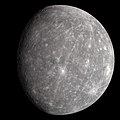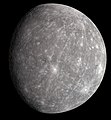Restr:Mercury in true color.jpg

Ment ar rakweled-mañ : 600 × 600 piksel. pizhderioù all : 240 × 240 piksel | 480 × 480 piksel | 768 × 768 piksel | 1 040 × 1 040 piksel.
Restr orin (1 040 × 1 040 piksel, ment ar restr : 408 Kio, seurt MIME : image/jpeg)
Istor ar restr
Klikañ war un deiziad/eur da welet ar restr evel ma oa da neuze.
| Deiziad/Eur | Munud | Mentoù | Implijer | Notenn | |
|---|---|---|---|---|---|
| red | 15 Mae 2023 da 08:16 |  | 1 040 × 1 040 (408 Kio) | CactiStaccingCrane | Reverted to version as of 10:42, 24 July 2022 (UTC) |
| 15 Mae 2023 da 08:01 |  | 1 024 × 1 024 (837 Kio) | CactiStaccingCrane | Manually merge the original monochrome image with the calibrated color image to eek out more resolution | |
| 24 Gou 2022 da 10:42 |  | 1 040 × 1 040 (408 Kio) | JCP-JohnCarlo | Make this planet image center | |
| 24 Gou 2022 da 10:25 |  | 1 040 × 1 040 (710 Kio) | JCP-JohnCarlo | Canvas image | |
| 3 Du 2019 da 09:00 |  | 960 × 1 040 (865 Kio) | Mirecki | User created page with UploadWizard |
Implij ar restr
Implijout a ra ar bajenn da heul ar restr-mañ :
Implij hollek ar restr
Ober a ra ar wikioù da-heul gant ar restr-mañ :
- Implij war af.wikipedia.org
- Implij war als.wikipedia.org
- Implij war ar.wikibooks.org
- Implij war as.wikipedia.org
- Implij war be-tarask.wikipedia.org
- Implij war beta.wikiversity.org
- Implij war bn.wikibooks.org
- Implij war bo.wikipedia.org
- Implij war ceb.wikipedia.org
- Implij war ckb.wiktionary.org
- Implij war csb.wikipedia.org
- Implij war cv.wikipedia.org
- Implij war cy.wikipedia.org
- Implij war de.wikipedia.org
- Implij war dty.wikipedia.org
- Implij war dz.wikipedia.org
- Implij war eml.wikipedia.org
- Implij war en.wikipedia.org
- Mercury (planet)
- Terrestrial planet
- The Planets
- Timeline of discovery of Solar System planets and their moons
- List of Solar System objects by size
- List of gravitationally rounded objects of the Solar System
- User:Kwamikagami/sandbox
- NASA
- User:Kazkaskazkasako/Books/Physical sciences
- Talk:Mercury (planet)/Archive 3
- User:Nrco0e/Userboxes
- User:Applekle/sandbox
- Wikipedia:Userboxes/Location/Extraterrestrial
- Talk:The Planets/GA1
- User:Double sharp/Largest Solar System objects
- User:TomMasterReal
- User:Nrco0e/Userboxes/FavMercury
- User:KeroseneLover100/sandbox/sandbox
- Implij war en.wikibooks.org
- Implij war en.wiktionary.org
- Implij war eo.wikipedia.org
- Implij war es.wikipedia.org
Gwelet muioc'h eus implij hollek ar restr-mañ.


